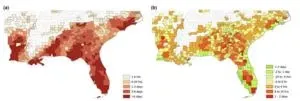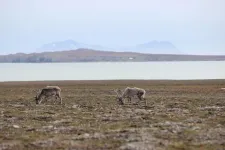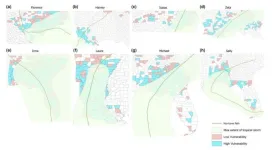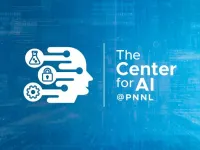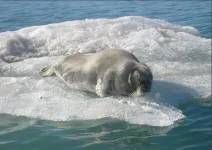(Press-News.org) Research published today in Nature sheds light on a small part of the so-called “dark genome” — the 98 per cent of the human genome whose biological function is largely not known.
In the study, an international multidisciplinary team reported the first high-resolution images and structural details of a genetic element known as LINE-1 (video here), which inserts itself into the human genome and is implicated in diseases such as cancer, autoimmune disorders and neurodegeneration, and even aging. The work provides a target for potential new treatments moving forward.
LINE-1 is described as an “ancient genetic parasite” with about 100 potentially active copies in each person. LINE-1 activity is often correlated with disease. Unlike DNA, which makes RNA and then proteins, retrotransposons like LINE-1 work backwards, making DNA from RNA and then inserting it into the genome.
“Retrotransposons are often referred to as ‘jumping genes’ that insert themselves into our chromosomes with a copy-and-paste mechanism,” explains Matthias Götte, professor and chair of the Department of Medical Microbiology and Immunology at the University of Alberta and one of the eight co-corresponding authors. “For this paper, we discovered the essential steps in this process, which could then lead us to ways to inhibit the enzyme and eventually treat those diseases.”
The team included researchers from institutions in the United States and Europe, as well as biotechnology partners. Götte’s lab was the only Canadian contributor to the research, which was led by investigators from Harvard Medical School and biotechnology company ROME Therapeutics.
The researchers say their analyses reveal the inner workings of the molecular machine that has written nearly half of the human genome, and that understanding LINE-1 structure and function is important both in evolution and, increasingly, in human disease.
The Götte lab, including research associate Egor Tchesnokov, provided much of the biochemical data in the paper. “It was a large team effort with world-class structural biologists,” says Götte. “Effective treatments for important human diseases can only be developed with a very strong scientific foundation.”
END
Researchers reveal full structure of ‘ancient genetic parasite’ implicated in human diseases
Understanding the mechanism of LINE-1 is key to developing potential new treatments for cancer, autoimmune disorders, neurodegeneration, even aging
2023-12-14
ELSE PRESS RELEASES FROM THIS DATE:
A promising pairing: Scientists demonstrate new combination of materials for quantum science
2023-12-14
Quantum information scientists are always on the hunt for winning combinations of materials, materials that can be manipulated at the molecular level to reliably store and transmit information.
Following a recent proof-of-principle demonstration, researchers are adding a new combination of compounds to the quantum materials roster.
In a study reported in ACS Photonics, researchers combined two nanosized structures — one made of diamond and one of lithium niobate — onto a single chip. They then sent light from the diamond ...
Move over Blitzen: geese outpace reindeer impacts on Arctic ecosystems
2023-12-14
In the frigid seas halfway between mainland Norway and the North Pole, two types of animals browse the palatable vegetation of a high-tundra archipelago, munching on thick moss, cropped grasses and low-lying shrubs. New research from a group led by Matteo Petit Bon from the Quinney College of Natural Resources is working to untangle the ecosystem impacts that two major players — geese and reindeer — have on a changing and vulnerable Arctic system.
Reindeer have been year-round residents on the islands of Svalbard for thousands of years, but at one point were almost completely gone. Svalbard ...
Research shows disadvantaged people wait significantly longer for power restoration after major storms
2023-12-14
Hurricanes and other extreme weather events often affect disadvantaged communities more severely, and extended power outages are some of the most harmful effects. Concerns over the intensification of hurricanes has led to new environmental justice policies that aim to mitigate the unequal impacts of major storms. Now, policy experts and engineers are directing their attention toward illuminating the causes.
Researchers at the Georgia Institute of Technology sought to investigate whether socioeconomically vulnerable households experienced longer power outage durations after extreme weather events. The team analyzed data from the top eight major Atlantic hurricanes between 2017 ...
PNNL creates Center for Artificial Intelligence
2023-12-14
RICHLAND, Wash.—The Department of Energy’s Pacific Northwest National Laboratory has created the Center for AI @PNNL to coordinate the pioneering research of hundreds of scientists working on a range of projects focused on science, security and energy resilience.
Researchers at PNNL were among the first to dive into artificial intelligence decades ago. But AI has surged in the past year with the ready availability of generative AI, which allows almost anyone to produce sophisticated—though sometimes errant—text and images with just a small amount of data. At the same time, AI is a vital tool for ...
Photonics research reveals potential for next-gen AR/VR and IoT
2023-12-14
USD$200,000 awarded to tackle today’s pressing consumer technology demands
Utilizing smart optical sensors for IoT
Providing more realistic virtual and augmented realities
WASHINGTON – The Optica Foundation today released more detailed information on information technology research funded by the 2023 Optica Foundation Challenge. Researchers Zaijun Chen, University of Southern California, USA, and Alejandro Velez-Zea, Universidad de Antioquia, Colombia, both proposed novel approaches to addressing the flow of data and information in consumer-centric technologies.
“The ...
Jurors recommend death penalty based on looks, but new training can correct the bias
2023-12-14
Certain facial features—like downturned lips and a heavy brow—are known to make someone appear untrustworthy to others, even though these do not indicate a person’s actual character. Such facial biases influence our everyday social interactions as well as high-stakes decisions, including who we hire, or elect to political office.
But a new study by Columbia researchers shows that the effects of these judgments can be mitigated. The study outlines the results of four experiments that the authors conducted with 1,400 volunteers. Through those experiments, the researchers found that when real-world defendants have facial features that appear untrustworthy, they are more likely ...
Closing the design-to-manufacturing gap for optical devices
2023-12-14
Photolithography involves manipulating light to precisely etch features onto a surface, and is commonly used to fabricate computer chips and optical devices like lenses. But tiny deviations during the manufacturing process often cause these devices to fall short of their designers’ intentions.
To help close this design-to-manufacturing gap, researchers from MIT and the Chinese University of Hong Kong used machine learning to build a digital simulator that mimics a specific photolithography manufacturing process. Their technique utilizes real data gathered from the photolithography system, so it can more ...
Seals stay warm and hydrated in the arctic with larger, more convoluted nasal passages
2023-12-14
Arctic seals have evolved many adaptations to cope with their frosty environment—one that you might not immediately think of is the bones in their nasal cavity. Arctic seals have more convoluted nasal passages than seal species that live in milder environments, and researchers report December 14 in the Biophysical Journal that these structures help the seals more efficiently retain heat and moisture as they breathe in and out.
“Thanks to this elaborate structure in their nasal cavities, Arctic seals lose less heat through nasal heat exchange than subtropical seals when both are exposed to the same ...
D-mannose reduces age-triggered changes in urinary tract that increase susceptibility to UTIs
2023-12-14
Aging poses a number of challenges to the body’s well-being, one of the most important being an increased susceptibility to multiple diseases, including urinary tract infections (UTIs). The connection between aging and more prevalent UTIs is not well understood, but now researchers at Baylor College of Medicine have found an explanation.
The researchers show in the journal Developmental Cell that, compared to the younger counterpart, the aging urinary tract in animal models changes how it functions at the cellular level in ways that seem to favor the establishment ...
Where patients live impacts whether they pick up their heart-failure medications
2023-12-14
People who live in neighborhoods with higher levels of poverty and unemployment are less likely to fill their heart-failure drug prescriptions than those living in wealthier areas, a new study shows. The findings not only add to understanding geographic and economic disparities in heart disease care, but also point to new ways to address barriers for patients taking these lifesaving drugs.
Led by researchers at NYU Grossman School of Medicine, the study explored prescription pickup patterns among patients with systolic heart failure, a chronic, life-threatening ...
LAST 30 PRESS RELEASES:
Oldest modern shark mega-predator swam off Australia during the age of dinosaurs
Scientists unveil mechanism behind greener ammonia production
Sharper, straighter, stiffer, stronger: Male green hermit hummingbirds have bills evolved for fighting
Nationwide awards honor local students and school leaders championing heart, brain health
Epigenetic changes regulate gene expression, but what regulates epigenetics?
Nasal drops fight brain tumors noninvasively
Okayama University of Science Ranked in the “THE World University Rankings 2026” for the Second Consecutive Year
New study looks at (rainforest) tea leaves to predict fate of tropical forests
When trade routes shift, so do clouds: Florida State University researchers uncover ripple effects of new global shipping regulations
Kennesaw State assistant professor receives grant to improve shelf life of peptide- and protein-based drugs
Current heart attack screening tools are not optimal and fail to identify half the people who are at risk
LJI scientists discover how T cells transform to defend our organs
Brain circuit controlling compulsive behavior mapped
Atoms passing through walls: Quantum tunneling of hydrogen within palladium crystal
Observing quantum footballs blown up by laser kicks
Immune cells ‘caught in the act’ could spur earlier detection and prevention of Type 1 Diabetes
New membrane sets record for separating hydrogen from CO2
Recharging the powerhouse of the cell
University of Minnesota research finds reducing inflammation may protect against early AMD-like vision loss
A mulching film that protects plants without pesticides or plastics
New study highlights key findings on lung cancer surveillance rates
Uniform reference system for lightweight construction methods
Improve diet and increase physical activity at the same time to limit weight gain, study suggests
A surprising insight may put a charge into faster muscle injury repair
Scientists uncover how COVID-19 variants outsmart the immune system
Some children’s tantrums can be seen in the brain, new study finds
Development of 1-Wh-class stacked lithium-air cells
UVA, military researchers seek better ways to identify, treat blast-related brain injuries
AMS Science Preview: Railways and cyclones; pinned clouds; weather warnings in wartime
Scientists identify a molecular switch to a painful side effect of chemotherapy
[Press-News.org] Researchers reveal full structure of ‘ancient genetic parasite’ implicated in human diseasesUnderstanding the mechanism of LINE-1 is key to developing potential new treatments for cancer, autoimmune disorders, neurodegeneration, even aging


